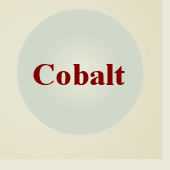Cobalt
On this Page
Introduction
Cobalt is a hard, lustrous, gray metal, and chemical element with symbol Co and atomic number 27. Cobalt is a naturally occurring element found in rocks, soil, water, plants, animals and humans. Moreover, it is a part of vitamin B12, which is necessary for neurological function, brain function, and the formation of blood.
Cobalt-containing products include corrosion and heat-resistant alloys, hard metal (cobalt-tungsten-carbide alloy), magnets, grinding and cutting tools, pigments, paints, colored glass, surgical implants, catalysts, batteries, and cobalt-coated metal (from electroplating). Radioactive isotopes of cobalt provide the following diagnostic and treatment tools: medical radioisotopes, industrial radiography (analysis of weld integrity), food irradiation, and concrete density measurements.
In the United States, more than a million workers are potentially exposed to cobalt and its compounds, with the greatest exposure in mining processes, cemented tungsten-carbide industry, cobalt powder industry, and alloy production industry. In addition, workers are exposed to cobalt in the production, processing, and use of hard metal; and the grinding and sharpening of steel tools with hard metal abrasives.
Chronic exposure to cobalt-containing hard metal (dust or fume) can result in a serious lung disease called "hard metal lung disease", which is a type of pneumoconiosis (lung fibrosis). Furthermore, inhalation of cobalt particles can cause respiratory sensitization, asthma, shortness of breath, and decreased pulmonary function.
Even though the primary route of occupational exposure to cobalt is the respiratory tract, skin contact is also important because dermal exposures to hard metal and cobalt salts can result in significant systemic uptake. Sustained exposures can cause skin sensitization, which may result in eruptions of contact dermatitis.
NIOSH Resources
NIOSH Pocket Guide to Chemical Hazards
Exposure limits, Respirator Recommendations, First Aid, more...
The Pocket Guide is a source of general industrial hygiene information on several hundred chemicals/classes found in the work environment. Key data provided for each chemical/substance includes name (including synonyms/trade names), structure/formula, CAS/RTECS Numbers, DOT ID, conversion factors, exposure limits, IDLH, chemical and physical properties, measurement methods, personal protection, respirator recommendations, symptoms, and first aid.
- Cobalt CAS No. 7440-48-4
International Chemical Safety Cards
An ICSC summarizes essential health and safety information on chemicals for their use at the "shop floor" level by workers and employers in factories, agriculture, construction and other work places.
Documentation for Immediately Dangerous to Life or Health Concentrations (IDLH)
The IDLH documents the criteria and information sources that have been used by NIOSH to determine immediately dangerous to life or health concentrations.
NIOSH Manual of Analytical Methods (NMAM)
NMAM is a collection of methods for sampling and analysis of contaminants in workplace air, and in the blood and urine of workers who are occupationally exposed.
- Elements (No. 7300) [PDF - 122.6 KB]
- Cobalt and Compounds (No. 7027) [PDF - 19.8 KB]
Specific Medical Tests or Evaluations Published in the Literature for OSHA-Regulated Substances: Cobalt
This database lists the specific medical tests published in the literature for OSHA regulated substances.
NIOSH Publications
Criteria for a Recommended Standard: Occupational Exposure to Cobalt
DHHS (NIOSH) Publication No. 82-107 (October 1981)
Presents a standard to prevent the adverse effects of exposure to Cobalt over a working lifetime.
Occupational Safety and Health Guideline for Cobalt [PDF - 229 KB]
Other Related Resources
Toxicological Profile for Cobalt (ATSDR)
OSHA (Chemical Sampling Information): Cobalt
EPA (Radiation Protection): Radioactive Cobalt
New Jersey Hazardous Substance Fact Sheet: Cobalt
NLM (Hazardous Substance Data Bank): Cobalt
NLM (Medline Plus): Cobalt Poisoning
IARC Monographs (Vol. 86): Cobalt in hard metals
IARC Monographs (Vol. 52-Summaries and Evaluations): Cobalt and Compounds
NTP (Report on Carcinogens): Cobalt-Tungsten Carbide: Powders and Hard Metals
NTP (Review of the Toxicological Literature): Cobalt Dust [PDF - 4.37 MB]
European Chemical Substances Information System (ESIS): Cobalt
INCHEM (Criteria Document for Swedish Occupational Standards): Cobalt and Cobalt Compounds [PDF - 241.5 KB]
- Page last reviewed: August 13, 2013
- Page last updated: August 15, 2013
- Content source:
- National Institute for Occupational Safety and Health Education and Information Division


 ShareCompartir
ShareCompartir
